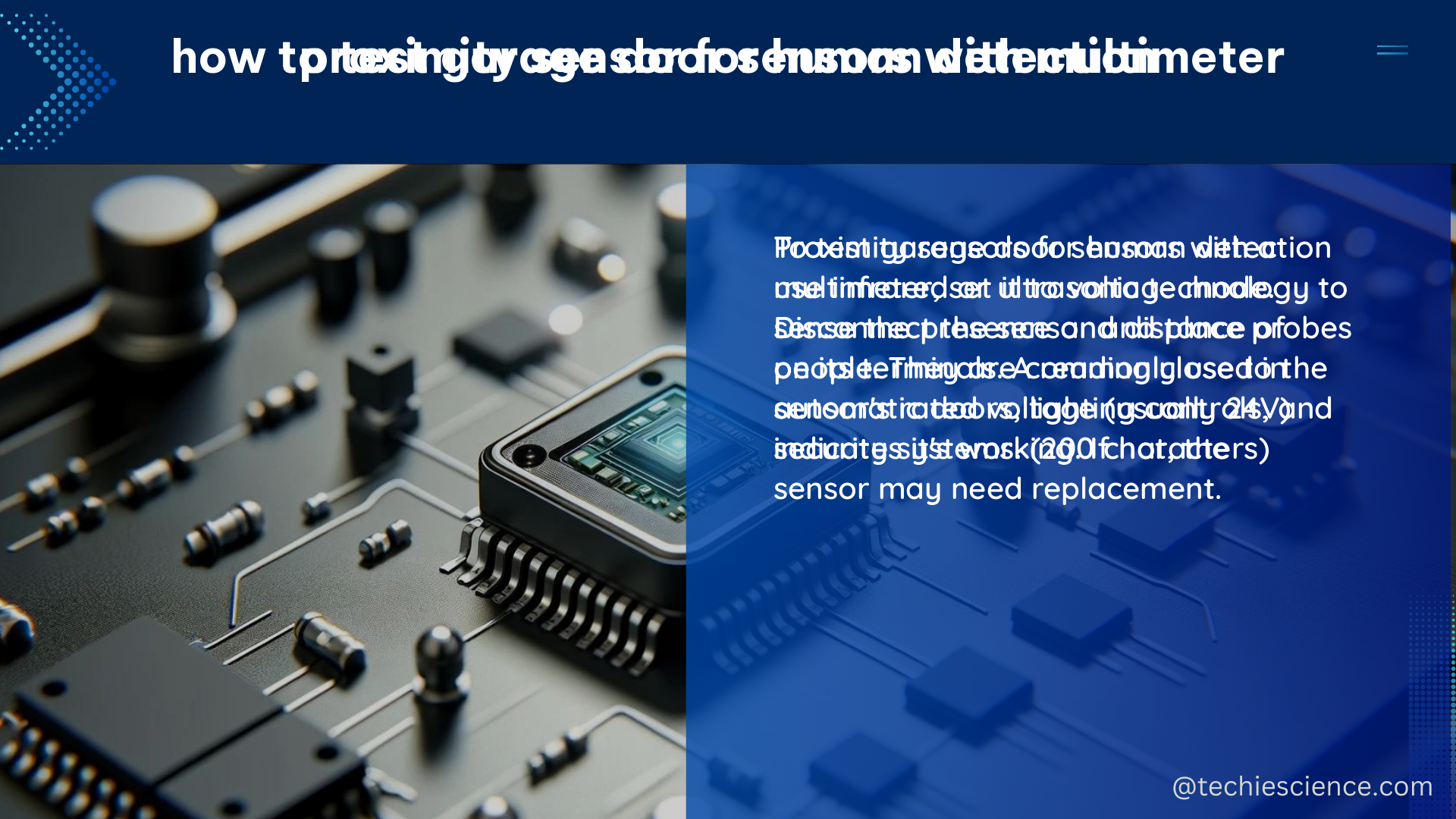Proximity sensors for human detection are essential tools in various applications, such as social contact characterization, object avoidance, and human activity recognition. These sensors, which can be ultrasonic or infrared (IR) based, have specific technical specifications that determine their performance and suitability for different use cases.
Ultrasonic Proximity Sensors
Ultrasonic proximity sensors, like the HC-SR04, are widely used for human detection due to their ability to detect objects within a range of 1-5 meters. These sensors are relatively accurate in measuring distance, with a typical accuracy of ±3 mm. They are also omnidirectional, meaning they can detect objects in any direction, making them suitable for applications that require 360-degree coverage.
One of the key advantages of ultrasonic sensors is their low power consumption, typically around 5-6 mA. This makes them ideal for battery-powered or energy-efficient applications. However, they can be triggered by non-animate objects, such as closing doors, and their directionality can be a limitation, requiring multiple sensors for comprehensive coverage.
The HC-SR04 ultrasonic sensor, for example, has the following technical specifications:
| Specification | Value |
|---|---|
| Operating Voltage | 5V DC |
| Operating Current | 15 mA |
| Ranging Distance | 2 cm to 400 cm |
| Ranging Accuracy | 3 mm |
| Beam Angle | 15 degrees |
| Trigger Input Signal | 10 μs TTL pulse |
| Echo Output Signal | TTL level signal |
| Dimension | 45 x 20 x 15 mm |
Infrared (IR) Proximity Sensors

Infrared proximity sensors, on the other hand, can detect objects within a shorter range of up to 1 meter. While they are less accurate in measuring distance compared to ultrasonic sensors, with a typical accuracy of ±5 mm, they are generally less expensive and can be used in applications where precise distance measurement is not required.
IR proximity sensors are more directional, requiring precise alignment with the object being detected. This can be a limitation in some applications, as it may require multiple sensors to achieve comprehensive coverage.
One example of an IR proximity sensor is the Sharp GP2Y0A02YK0F, which has the following technical specifications:
| Specification | Value |
|---|---|
| Operating Voltage | 4.5 – 5.5V DC |
| Operating Current | 30 mA |
| Sensing Distance | 20 cm to 150 cm |
| Sensing Accuracy | ±5 mm |
| Beam Angle | 20 degrees |
| Response Time | 39 ms |
| Dimension | 43 x 24 x 16 mm |
Social Contact Characterization
In the study of social contact characterization using wearable proximity sensors, the sensors are typically set to detect proximity events between devices situated within a range of 1-1.5 meters of one another. The attenuation of the signals with distance is computed as the difference between the received and transmitted power to estimate how close individuals are.
A ‘contact event’ is identified when the devices exchange at least one radio packet during a time interval of 20 seconds. Each device has a unique identification number to link the information on the contacts established by the individual carrying the device.
This approach allows researchers to study social contact patterns, which can be useful in understanding the spread of infectious diseases, social dynamics, and other human behavior-related phenomena.
Human Activity Recognition
In the context of human activity recognition, smartphones are equipped with a variety of sensors, including accelerometers, gyroscopes, magnetometers, GPS, proximity sensors, and light sensors. These sensors provide measurements with respect to the three orthogonal axes of the body of the phone for inertial sensors and are orientation-invariant for the remaining sensors.
The most commonly used sensors for human activity recognition are the accelerometer, gyroscope, and magnetometer, which capture data about acceleration, angular velocity, and phone orientation, respectively. However, proximity sensors can also play a role in activity recognition, particularly in identifying proximity-related events, such as when a user is holding the phone or interacting with it.
By combining data from multiple sensors, researchers and developers can create more accurate and comprehensive human activity recognition systems, which can be used in a wide range of applications, from fitness tracking to smart home automation.
Conclusion
Proximity sensors for human detection are essential tools in various applications, offering unique capabilities and technical specifications that determine their performance. Ultrasonic sensors excel in distance measurement and omnidirectional detection, while IR sensors are more cost-effective and suitable for applications where precise distance measurement is not a priority.
Understanding the technical details and use cases of these sensors is crucial for designing effective solutions for social contact characterization, object avoidance, human activity recognition, and other applications that require accurate and reliable human detection.
References:
– Using wearable proximity sensors to characterize social contact patterns in a village in rural Malawi. EPJ Data Science, 10(1), 1-26.
– Recommendation for sensor to use to detect human proximity. Arduino Forum.
– Sensor System – an overview | ScienceDirect Topics.
– A systematic review of smartphone-based human activity recognition: Challenges and opportunities. Sensors, 21(9), 3167.
– Sensor-based proximity metrics for team research. A validation study. International Journal of Human-Computer Studies, 132, 102522.

The lambdageeks.com Core SME Team is a group of experienced subject matter experts from diverse scientific and technical fields including Physics, Chemistry, Technology,Electronics & Electrical Engineering, Automotive, Mechanical Engineering. Our team collaborates to create high-quality, well-researched articles on a wide range of science and technology topics for the lambdageeks.com website.
All Our Senior SME are having more than 7 Years of experience in the respective fields . They are either Working Industry Professionals or assocaited With different Universities. Refer Our Authors Page to get to know About our Core SMEs.